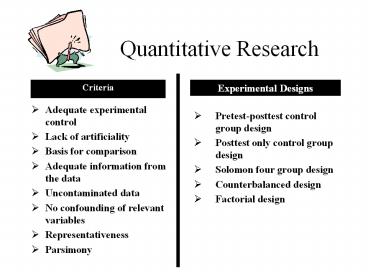Quantitative Research - PowerPoint PPT Presentation
Title:
Quantitative Research
Description:
Parsimony. Pretest-posttest control group design. Posttest only control ... The experimental design should be structured in such a way that the ... Parsimony ... – PowerPoint PPT presentation
Number of Views:54
Avg rating:3.0/5.0
Title: Quantitative Research
1
Quantitative Research
Criteria
Experimental Designs
- Adequate experimental control
- Lack of artificiality
- Basis for comparison
- Adequate information from the data
- Uncontaminated data
- No confounding of relevant variables
- Representativeness
- Parsimony
- Pretest-posttest control group design
- Posttest only control group design
- Solomon four group design
- Counterbalanced design
- Factorial design
2
Criteria 1Adequate Experimental Control
- There are adequate restraints, or controls, on
the conditions of the experiment. - With controls in place the researcher should be
able to accurately interpret the results. - The experimental design should be structured in
such a way that the experimental variable (or
treatment) effect can be detected.
3
Criteria 2Lack of Artificiality
- The experiment must be conducted in such a way
that the results will apply to the real
educational world.
4
Criteria 3Basis for Comparison
- There must be some way to make a comparison to
determine whether or not there is an experimental
effect. - In some cases a control group is used (control
groups do not receive the experimental
treatment). - In some cases multiple treatments may be studied
against an external criterion (i.e. Different
reading techniques may be examined to assess
their relative impact on student reading scores).
5
Criteria 4Adequate Information From the Data
- There must be adequate data for testing the
hypothesis. - The data must be such that statistical testing
will be precise enough for the researcher to make
a decision about the hypothesis.
6
Criteria 5Uncontaminated Data
- The data should adequately reflect the
experimental effects. - The data should not be affected by poor
measurement or errors in the experimental
procedures. - Example subjects in an experiment should not
communicate across groups (control and
experimental).
7
Criteria 6No Confounding Variables
- Confounding of variables occur when two or more
variables cannot be separated. - Experimental controls should be such that
variables can be isolated. - Translation the relationship between independent
variable and the dependant variable can be
measured with confidence in that another variable
is not contributing to the effect.
8
Criteria 7Parsimony
- Keep it simple!
- This criterion means that, with all other factors
being equal, a simple design is preferred to a
more complex one. - Note simple designs are usually easier to
implement, and may yield data that is easier to
interpret.
9
QuantitativeExperimental Designs
This family of research designs is characterized
by random selection of subjects. The
following experimental designs are based on the
problem statement The effects of teaching
method(s) on history achievement.
10
Experimental Design 1Pretest-Posttest Control
Group Design
Diagram
O O
O O
X1 X
11
Experimental Design 2Posttest-Only Control
Group Design
Diagram
O O
X1 X
12
Experimental Design 3Solomon Four Group Design
Diagram
O O
X1 X
O O
O O
X1 X
13
Experimental Design 4Counterbalanced Design
Diagram
X1 X
O O
O O
X X1
14
Experimental Design 5Factorial Design
Diagram
Independent Variable 1 Teaching Method
Lecture Only Reading/Lecture/Small Groups
Randomly assigned 3rd graders scoring above 85 on an aptitude test. Randomly assigned 3rd graders scoring about 85 on an aptitude test.
Randomly assigned 3rd graders scoring below 60 on an aptitude test. Randomly assigned 3rd graders scoring below 60 on an aptitude test.
Independent Variable 2 Aptitude































